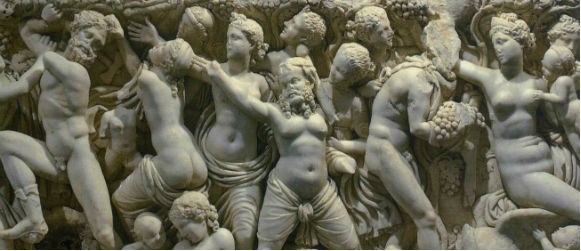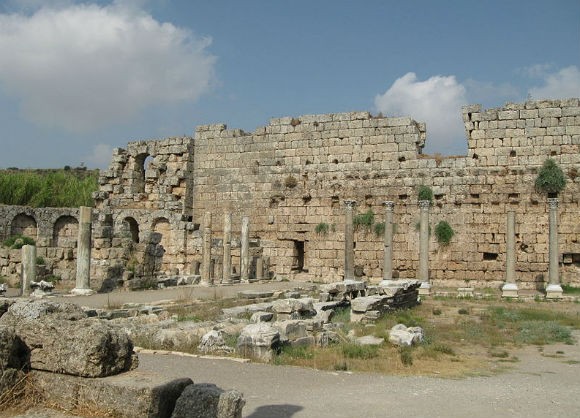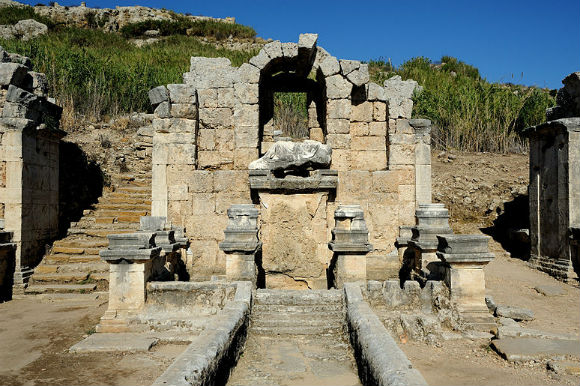Perga was an old city even in the first century. Its name (which is not Greek) indicates that its origin dates from pre-Greek times. Alexander the Great passed through it twice while the Pergaeans offered no resistance to him although it was a walled city with a citadel. In Roman times the main streets were over twenty-one meters wide. They were lined with Ionic colonnades and a water channel ran down their center in a series of small waterfalls as in Antalya today. Behind the colonnades stood the shops. Of the early buildings the stadium and the theater have survived the ravages of earthquakes and wars with the least damage. In fact this stadium which could seat about fourteen thousand people is one of the best preserved in Turkey.
The temple of the Pergaean Artemis according to a writer of the time was “a marvel of size, beauty, and workmanship.” Its location has yet to be established; it may have been where there are now ruins of a Byzantine church on a hill to the southeast of the city.
Perga is on a rise not far from the Cestrus River which was navigable In Paul’s time. It was not a seaport in terms of Its being directly on the Mediterranean even then, but rather it was more easily defended where it was: its distance from the open sea made it less vulnerable to piracy.
Two people stand out among the early residents of Perga. Apollonius was a third century B.C. astronomer and mathematician who believed that the movements of heavenly bodies in the universe were explainable by orbits within orbits: that the moon went around the earth as the earth went around the sun. He was much ahead of his time in his theories of astronomy, so much so that the ideas had to be rediscovered during the Renaissance. Plancia Magna was unusual for a second century A.D. woman: she held the highest city office during her life, that of demiurgus. She must have been well-to-do for a number of inscriptions record her gifts to the city.
Paul and Barnabas went through Perga on their way to and from Antioch on their first journey (Acts 13:13, 14:25). John Mark was with them at first but left them at Perga to return to Jerusalem. The reason for that must have been such that Paul doubted his commitment to the cause. Later when Paul and Barnabas were about to start on their second journey from Antioch they had a sharp dispute over his worthiness. Paul refused to have him go along, so John and Barnabas went to Cyprus while Paul chose Silas to accompany him.
Paul talks in II Corinthians 12:7 and in Galatians 4:13-14 of bodily illness that brought him to Galatia the first time. It may have been on that account that he did not stay long in Perga the first time. Whatever the illness was, it seems to have improved in time in the dry mountain air to the north.
The second theory of why they did not stay long in Perga is that their interview with Sergius Paulus, the proconsul of Cyprus, had made them want to hurry to the Roman colony in Antioch of Pisidia. This interpretation may lay too much stress on the lasting importance of that meeting with a cultured Roman who could have been more interested in the pursuits of the mind than the salvation, in Christian terms, of his soul. It is interesting, however, that this is” the point in Acts (13:9) that Luke begins to call Paul by his Roman name, not his Jewish “Saul”.
On their return they did stay in Perga long enough to preach and talk with people there. Nothing else is told about the city or their time there.
Perga,






We visited Perge along with Aspendos and Side on a day tour with Nirvana tours which you can book locally in Antalya or online. The guide was great and it was excellent value for money
As they told us this city is mentioned in Bible, since Paul used to prophet there. Make sure to walk to THE END of the main street. Usually tourists must go there by themselves. It's a 10-15 minutes walk under the sun, but it's really worth it.
The statues and the historical site is excellent, you should also sea the statues from Perge in City Museum.
liked the follow on to the amphitheatre …but could nt get excited or motivated by perges
If you like history then Perge is definitely worth seeing. It is a vast site dating back to the Roman era. You do need some imagination to recreate what was once clearly an amazing city, but it's a fascinating place.
Perge is fascinating and full of interesting stories but … among all of the other monuments surrounding Antalya it is the least "grandiose".
We went as part of a tour taking in two other attractions which I will also review
We were given a lectur for maybe an hour or so in total giving background information when it was built and that kind of thing the guide was very informative we were then given half an hour of free time which was not…
This Location may be familiar to the people who used to visit the rmanents in the mideterrenian area. It is a nice place but it was strange that there was no entry to the theater which may be the main attraction there.
Much smaller than Pompeii (Italy) so not too daunting for all ages. Good maps and descriptions covering the different areas and some interesting restoration work being undertaken. Well worth a visit.
go very early in the morning to avoid lots of tourism